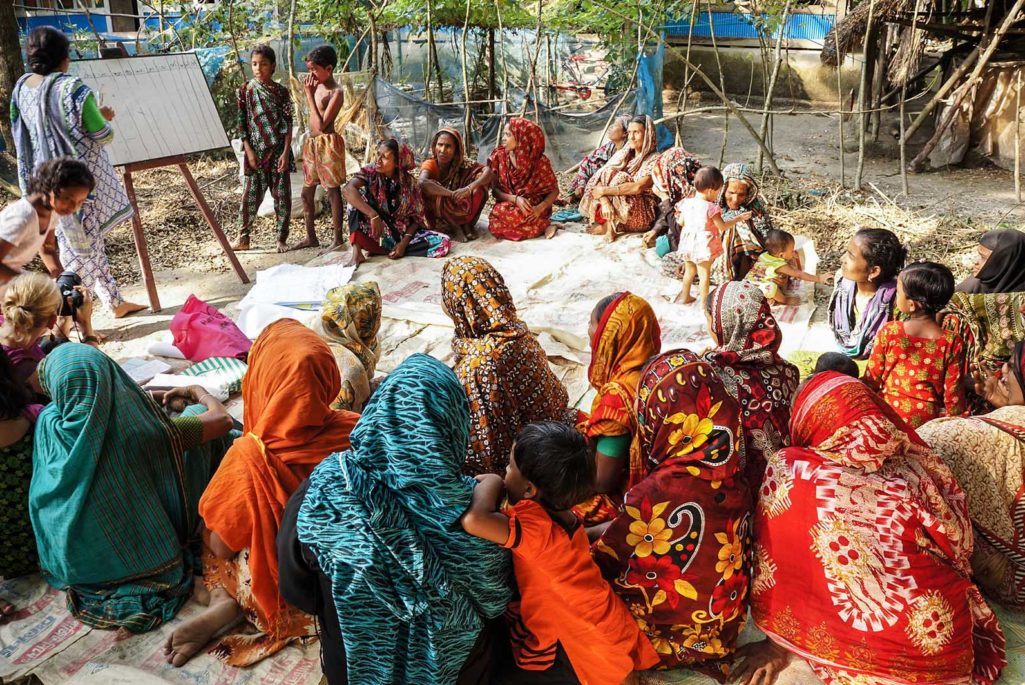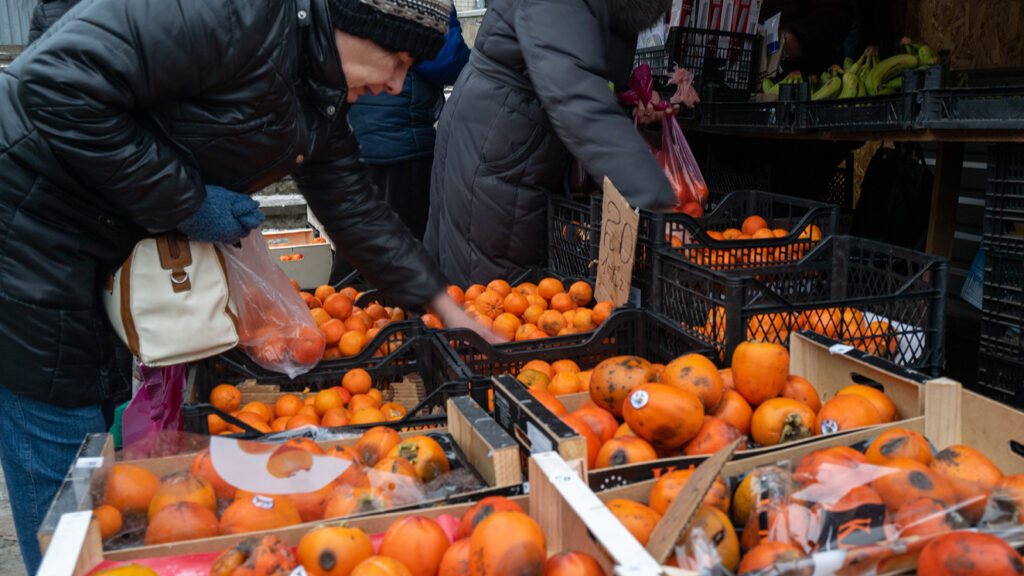For Farmers, Insurance is an Investment in the Future

Participatory discussions on agricultural calendars with a women's group in Gabgachia, Bagerhat (Bangladesh), to identify the types of crops grown by them and by their husbands, and the times of the season that are most vulnerable to weather events. This is key information in designing a useful index insurance product.
Photo: Melody Braun/IRI
Smallholder farming is big business. Two and a half billion people rely on small farms for their income and they produce more than half the world’s food, assisted by a vast supporting cast of input companies, banks, processing plants, markets, NGOs and research centers.
However, smallholder farming is also extremely vulnerable to the whims of the weather. Most farms are based in developing countries without access to irrigation, so a “bad year” due to a drought or a flood can be catastrophic. In many places, the impact from climate change—such as higher temperatures, stronger storms and changes in rainfall patterns—threaten to make the situation even harder to predict. Farmers around the globe must manage these risks to survive, so a commonly used strategy is to work to become even more productive in the good years, allowing them to offset their losses in the bad.
One way to achieve that productivity is to invest in new inputs or technology, but the risk of doing that can often leave farmers even more vulnerable to the weather. For example, a farmer might increase her yields in a normal year by taking out a loan to purchase high-quality seeds and fertilizer. But if a severe drought strikes, there is the chance she will lose everything and go into debt. Furthermore, if the banks believe that the farmer is high-risk, they may not be willing to give her a loan in the first place. This means that, unfortunately, threats like drought—the very reason for adopting these climate-smart practices—also represent a huge risk that make farmers reluctant to invest.
Insurance is one method to reduce this risk. If the safety of insurance coverage can increase a bank’s willingness to make loans or help farmers feel comfortable making additional investments, then farmers can take advantage of productive opportunities that bring them higher income in most years, knowing that their investment is protected. In other words, insurance can build resilience not only by providing a safety net to help farmers survive and protect their assets, but it can also unlock opportunities to increase productivity in the normal years.
Yet most farmers around the world remain uninsured. This is in part because traditional indemnity insurance, where a payout is based on measured damage, is difficult to apply to the situation. It is extremely expensive to visit every smallholder farmer to assess losses, and it’s incredibly difficult to differentiate between bad management and true losses from something such as drought. Index insurance was created as an alternative approach. The concept is simple: If there’s a big, obvious risk such as a drought that stops farmers from being more productive, then why not instead insure the drought?
Index insurance works through allowing farmers to purchase coverage based on some index that’s closely linked to their losses, instead of on directly measured damage. Indices might be based on an aspect of weather that influences yield—such as the wind speed or the total rainfall during a certain window of time—or they could be based on other factors, such as the average yield losses over an entire district.
A payout is triggered when an index falls above or below a pre-specified threshold. A well-designed index should be closely linked to the loss it’s there to insure, plus it needs to be externally measurable, tamper-proof and easy to understand by the customer. If that is the case, index insurance has the potential to unlock a massive market of smallholder farmers and to increase uptake in new technologies and inputs.
Insurance Acceptance on the Rise
In recent years, the number of farmers who have purchased index insurance contracts has spiraled. In India, more than 35 million farmers are part of a government run index insurance program. Since 2009, more than 800,000 farmers have chosen to purchase insurance across East Africa through the company ACRE (previously Kilimo Salama). In 2015, more than 40,000 of the poorest smallholder farmers voluntarily chose to purchase insurance through the R4 Rural Resilience Program (World Food Program and Oxfam America). The trend is set to continue, with farmers able to purchase premiums in at least 20 countries around the world.
Many analysts often discuss the “low demand” of index insurance programs, so it’s worth noting that from a commercial perspective, uptake is often capped by logistics rather than farmer demand. Also, the uptake of many “disappointing” projects often exceeds that of comparable products in the U.S. or Europe.
Index insurance is no panacea; it isn’t going to singlehandedly solve poverty or offer farmers protection against every risk they face. Very few insurance pilots scale to reach meaningful numbers of farmers, and there are many challenges they have had to overcome in order to do this, including:
Finding the right situation—Index insurance works best in locations where there is one single overriding risk that stops farmers from being productive, such as drought in Senegal. It’s less useful in places that have more complex risks; for example, it would be less helpful in a region where farmers face risks from flood, drought and disease. Insurance also works well in situations where it can unlock a new option (such as allow access to credit), or to protect an existing asset (such as livestock), as the extra money made by the farmer in good years is then enough to pay the premium. It must also fit in with farmers’ existing risk management strategies in order to be an attractive product. Finding the right opportunities for insurance to thrive takes time and close work with local partners, agricultural experts and farmers themselves.
Building capacity and including farmers in the design process—Everyone prefers a custom-designed product to one that’s off-the-shelf, so it’s unsurprising that index insurance is more successful in situations where farmers can be involved in the design process. Insurance is often a very new idea for farmers, so being included in the design stage allows them time to better understand the product. Farmer-led design has been shown to significantly increase sales, support development and unlock creative new ideas. For example, in Ethiopia, it was a farmer who suggested that people who didn’t have the cash to purchase insurance could pay for it though working on a “food-for-work” program, unlocking an entirely new market.
Reducing basis risk and improving index design—Working out exactly which aspect of the weather most closely relates to a bad year is complicated, and even the most simple of indices will be backed up by a lot of sophisticated analysis. It’s also impossible to perfectly correlate this index with the actual damage on every farm. The difference between an individual farmer’s loss and the payouts from the insurance contract is called basis risk. There is much research on methods to reduce this, from improving our knowledge of spatial statistics to making use of new satellite-based weather products, but this research must be customized for each new project. Communicating basis risk to the customer is equally important; if a farmer knows when he is (or isn’t) covered through a transparent index, it’s easier to trust it and to fit insurance into farm management plans.
Setting up networks—Index insurance is a unique new area in that a large project will require meaningful collaboration among farmers, local insurers, global re-insurers, banks, input companies, agricultural experts, meteorologists, remote sensing experts, social scientists, economists, NGOs and business experts. It requires time and patience to build up this network and for everyone to learn how to speak the same language.
Finally, one of the most important lessons stemming from index insurance is that no matter how simple the theory, reality is always complicated and nuanced. Index insurance programs can fill multiple roles with many ideas of success, so simple narratives often miss the subtleties of a situation or the full story behind it. There are many examples where index insurance ended up playing a different role than intended, and programs often take several years to fully develop.
So as with any business, perhaps the magic ingredients in index insurance are good communication, patience and an adaptable business plan.







